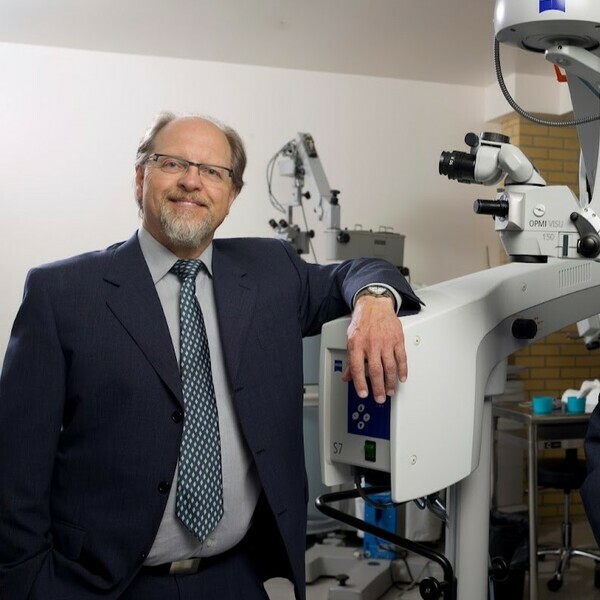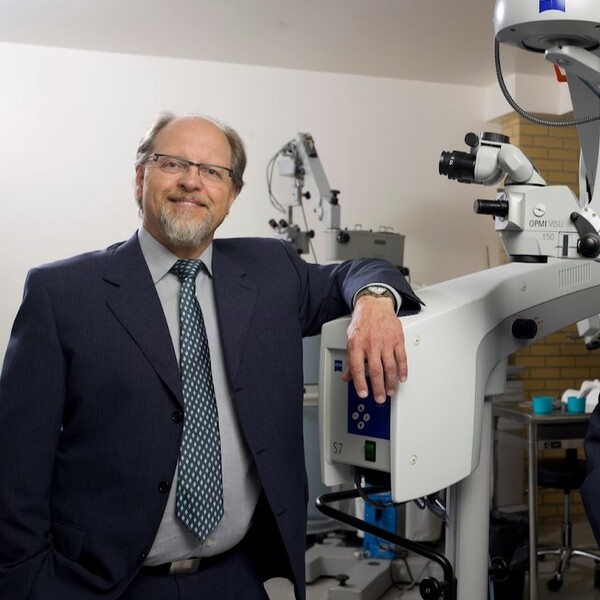Stories With VisionInvesting in the Future of Sight
Posted on: May 01, 2025This Vision Health Month, take time to learn about the importance of the Eye Institute of Alberta from Dr. Morely Kutzner and discover how it is changing the future of vision care through education, research, and treatment.

May is Vision Health Month, a time to highlight the importance of sight and the perfect time to discuss one of Alberta's most vital medical and research institutions: the Eye Institute of Alberta (EIA). Tucked within the walls of the Royal Alexandra Hospital, the EIA is not only a place where lives are being changed but also a place where the future of vision care is being built.
Among the dedicated leaders helping to shape that future is Dr. Morley Kutzner, a long-serving ophthalmologist whose career has been defined by compassion and curiosity. Dr. Kutzner's journey into the world of eye care began in his formative years when he heard of a man in Africa who had gone blind and could no longer navigate daily life safely. To help him move about—whether to the market or simply around his village—his grandchildren would help guide him using a large branch.
What struck Dr. Kutzner wasn't just the man's loss of independence but the children's sacrifice. While others their age were in school or out playing, these young kids had become full-time caregivers, their childhoods shaped entirely by the absence of one man's vision.
"That image just stuck with me," Dr. Kutzner recalls. "It planted the seed early on. Seeing those kids lead around a man who must've been only 50 or 60 made me think vision isn't just about one person's health—it affects whole families and communities."
That sentiment has led Dr. Kutzner to understand just how vital vision health is and its profound impact on lives.
"I've spoken with people who would rather lose a limb. They'd rather have a heart attack. They'd rather have a stroke. Anything other than to lose their vision." – Dr. Morley Kutzner
Vision health is one of the most cost-effective medical investments a donor can make. In terms of impact on an individual's life, vision care consistently ranks among the highest-value outcomes. In simpler terms, the improvement in quality of life gained from restored or preserved sight far outweighs the cost of treatment.
"Let me give you one example of the value we can help give someone. If you have a patient who can't drive anymore because she can't see properly, she will need help completing even the most basic life tasks. Suppose she receives cataract surgery in both eyes for minimal cost. Her independence will be restored. She will be back driving in her car, going to Safeway, living independently, and visiting the grandchildren. You've just given her life back. You have treated more than just their sight; you have improved their quality of life." – Dr. Morley Kutzner
But, for Dr. Kutzner and those at the Eye Institute of Alberta, it's not just about treating an eye—it's about treating a person in their entirety. Dr. Kutzner emphasizes that the care provided at the EIA is relational, not transactional.
"Anybody can be a robot and say, 'You're number three, in and out, goodbye.' But that's not the way we want to work. We want to say, 'Yes, you're patient number three, but you're also a person. You have a family. You have concerns. We understand you. We want to help you.'"
This deeply human approach sets the EIA apart. It reminds us that eye care is more than the organ—emotion, trust, and compassion. That relational foundation is what helps people feel truly seen.
This belief has carried Dr. Kutzner through decades of service at the EIA, where he has witnessed firsthand the transformative power of vision care. From restoring sight to patients across the province to training the next generation of ophthalmologists and contributing to cutting-edge research, the EIA represents a commitment to healing today and building a better tomorrow by securing the latest equipment and care technologies and training future generations of ophthalmologists.
"People often think something like cataract surgery is a simple, easy procedure. Let me tell you, it's quite the opposite. It's tremendous concentration. You're working in distances of fractions of a millimetre. You're working with a patient who's almost always awake and can move. And so, if your tolerance levels for success or failure are less than a millimeter, can you imagine trying to do your work on a patient who's awake and who's quite capable of moving?" – Dr. Morley Kutzner
That level of training requires time, guidance, and—critically—the proper equipment, which can be difficult to master.
"Using this equipment isn't like flipping a switch. It's like playing the organ," says Dr. Kutzner. "You're using your eyes, ears, hands, feet, brain—everything. It's all working together to do something incredibly delicate."
Without the right machines—and enough time to train on them—the skills required to perform these intricate surgeries simply can't be passed on. Investing in modern technology benefits today's patients and safeguards the future of care by preparing new specialists to carry the torch.
That's why support for institutions like the EIA is crucial. It ensures that the next generation of eye surgeons is equipped with the knowledge, precision tools, and experience needed to deliver truly world-class care.
As we celebrate Vision Health Month, now is the time to invest in the future of sight, Dr. Kutzner and the team at the Eye Institute of Alberta.
Your support helps provide the equipment, training, and research necessary to care for today's patients and future generations.
When you give to vision, you're giving more than sight—you're giving people their future.
Learn more about how you can support the Eye Insitute of Alberta.
